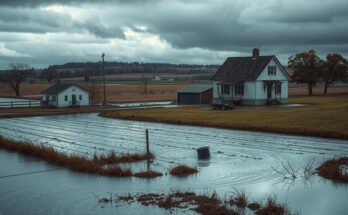Fog harvesting may offer a crucial water source for dry cities like Alto Hospicio, Chile. Researchers have found the area’s regular fog provides opportunities for sustainable drinking water solutions. This process could meet community water needs and enhance agricultural production, helping to address the resource challenges faced in arid environments.
Fog harvesting presents a viable solution for providing drinking water to some of the world’s most arid cities, as indicated by research conducted in Alto Hospicio, Chile. This desert city receives an average of less than 0.19 inches of rainfall annually and faces significant social challenges, including widespread poverty and limited access to clean water supplies. Many residents rely on trucked water deliveries, which heighten the urgency for sustainable solutions.
The fog that envelops Alto Hospicio could be effectively harvested using a straightforward method. A mesh mesh is suspended between poles, allowing droplets to form as moisture-laden clouds pass through. As these droplets collect, they can be directed into storage tanks through a network of pipes. Though this method has been practiced on a smaller scale in rural areas of South and Central America, scaling it up offers promising potential for urban areas.
Dr. Virginia Carter Gamberini, the lead researcher from Universidad Mayor, anticipates a new era of extensive fog harvesting to increase urban water supplies significantly. Her research team’s studies incorporated satellite imagery and weather forecasts to assess the water-generating potential of fog over the Pacific, ultimately concluding that this natural resource could meet the pressing needs of Alto Hospicio’s residents. Their findings were published in “Frontiers of Environmental Science.”
The fog in Alto Hospicio forms when warm air from the Pacific Ocean interacts with the cold waters, creating unique harvesting opportunities. The researchers estimated that an area of approximately 17,000 square meters of mesh could generate enough water to satisfy the weekly demand of 300,000 liters currently delivered to urban slums, while 110 square meters could cater to recreational irrigation needs. The fog water could additionally support hydroponic agriculture, producing significant vegetable yields.
With the Atacama Desert ranking among the driest regions globally and traditional water supplies dwindling due to the increasing urban population and industrial demands, alternative sources of clean water are critical. Dr. Gamberini noted Chile’s unique geographic advantages for sea fog production and indicated ongoing efforts to create a national fog harvesting map. She asserts that harvesting “water from the clouds” will enhance urban resilience to climate change and improve access to safe drinking water.
The potential for fog harvesting to provide sustainable water sources in Alto Hospicio underscores an innovative approach to addressing water scarcity in arid urban environments. This method not only promises to meet the immediate drinking water demands of impoverished communities but also supports agricultural initiatives. As researchers continue to map and assess fog harvesting capabilities across Chile, urban resilience to climate change and improved public health outcomes may become achievable goals.
Original Source: www.bbc.com




